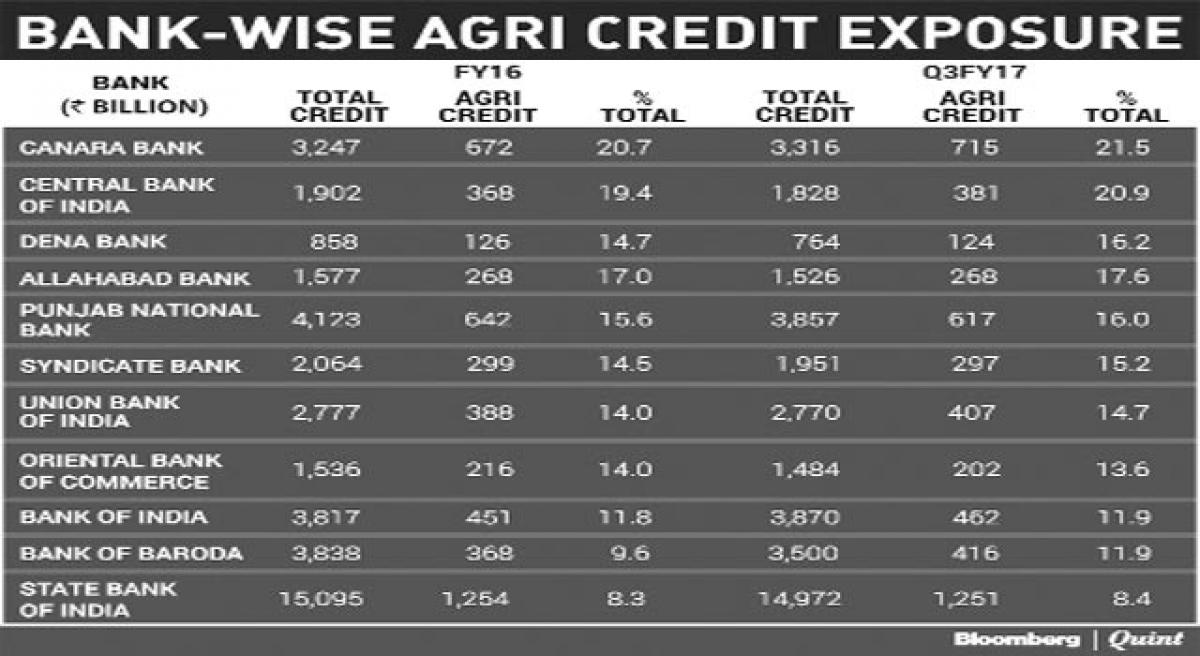Live
- GMR Airports Unveils AI-Powered Digital Twin Platform to Transform Airport Operations
- India poised to become leading maritime player: PM Modi
- Top Causes of Kidney Stones and How to Recognize Silent Symptoms
- India’s renewable energy capacity logs 14.2 pc growth at 213.7 GW
- Winter Session of Odisha Assembly adjourned sine die
- Biden calls Trump's tariff approach 'major mistake'
- After Drama Over Eknath Shinde’s Chief Minister Race, Maharashtra Cabinet Formation Faces New Tensions
- Egyptian FM, Blinken discuss recent developments in Syria
- Iran's supreme leader says Syria's developments result of US-Israeli 'plot'
- Elon Musk to Purchase $100 Million Luxury Mansion Next to Donald Trump's Mar-a-Lago, Report Reveals
Just In

Uttar Pradesh has heralded the season of loan waivers with a bumper financial harvest for farmers in the State in the form of waiver of loan of up to Rs 1 lakh for each of the 2.15 crore small marginal farmers at a total cost to the government of Rs 36,359 crore.
Uttar Pradesh has heralded the season of loan waivers with a bumper financial harvest for farmers in the State in the form of waiver of loan of up to Rs 1 lakh for each of the 2.15 crore small marginal farmers at a total cost to the government of Rs 36,359 crore.
In the Assembly elections, Prime Minister Narendra Modi played the most magical card politicians can use for getting farmers on board -- waiver of loans. It appears the temptation to Modi to make a political killing was irresistible.
The promise made good electoral sense but demonstrated bad economic wisdom. Such palliatives have crippling impact on the economy and distract the State from much needed reforms which are a more prudent and sustainable path to a solution for the protracted crisis for more than half of the country’s population.
The winter of Uttar Pradesh will most likely be followed by the spring in Maharashtra, Karnataka, Punjab, Kerala and Haryana where farmers are equally worse affected. Maharashtra has already demanded waiver of farm loans worth Rs 30,500 crore.
There are 1.18 crore farmers in the State with a debt of Rs 1.05 lakh crore. Of these, around 31 lakh farmers could have to immediately pay loans amounting to Rs 30,500 crore.
Such populist measures will clearly dent Modi’s reformist agenda. Any large-scale farm-loan waiver worsens the situation for banks. It is a very tough test for the reformer in Modi.
The last big national loan waiver was done by the Congress-led United Progressive Alliance government in 2008, which had announced a debt waiver of Rs 71,000 crore (Rs710 bn) covering all types of farmers. The scheme benefited around 50 million of more than 140 million farm households. The scheme cost the State around 1.7 per cent of GDP.
Economists and bankers loathe the idea of State-sponsored loan write-offs as these create a perverse incentive, distorts the loan market and puts a premium on defaults.SBI Chairman Arundhati Bhattacharya had recently cautioned that farm loan waiver will disrupt credit discipline among borrowers.
Reserve Bank Governor Urjit Patel has warned that loan waiver schemes “engender moral hazard”, undermining honest credit culture and impairing incentives for borrowers to repay bank loans. Experts argue loan write offs are a disincentive to the banking system because people have expectations of future waivers as well. As such, future loans given often remain unpaid.
The borrowers see value in strategic defaults. While it is important for banks to make credit available to farmers so that they can leverage and do better, it is also important to maintain a credit discipline. Loan waiver schemes vitiate the credit culture and make it tougher for banks to continue lending to these segments. They create moral hazards in the financial system by rewarding those farmers who default on their loans, offering nothing to those who pay.
“The government knows we will take out more loans in the end and fall in the same trap again and will withhold repayment of these loans too waiting for the next election for the loan to be waived,” said Vithal Mhaski, a cotton farmer in Maharashtra who is Rs 77,000 in debt.
Bankers rue that large chunk of farm loans goes only to buy seeds or fertilizers, rather than on mechanisation. India is the world’s second-biggest producer of rice, wheat, cotton and sugar, but its productivity is way below the world average. Bankers bemoan the rise in ‘willful’ defaults among those taking agricultural loans and using them to marry off their daughters or become lenders themselves.
Critics say many of the smallest and most financially desperate farmers will not be eligible for the scheme because it applies to bank loans. The poorest farmers usually borrow from money lenders. In a sense, it’s also a story of unfinished reforms in India. The question should be why almost 55 percent of the population is producing only 17 percent of the output. Unless this huge swathe of the population is empowered, loan waivers will remain a constant feature of the landscape.
In a recent note, Kotak Mahindra pointed out that loan waivers have become a trend in the run-up to elections. A regular phenomenon of waivers would eventually result in banks silently pulling back lending a few quarters ahead of elections or look to increase interest rates to compensate any risk, both of which do not lead to the best outcomes.” Surely, food for thought for the polity! (INFA)
By Moin Qazi

© 2024 Hyderabad Media House Limited/The Hans India. All rights reserved. Powered by hocalwire.com







